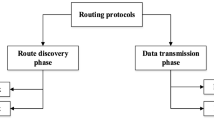Abstract
This paper proposes an adaptive routing and spectrum assignment protocol for heterogeneous Full-duplex (FD) and half-duplex (HD) cognitive radio (CR) networks. The key design goal of the developed protocol is to select a path between a source-destination pair, and to optimally assign channels to each hop along the selected path. One main feature of the proposed protocol is that it takes into account the dynamic activity of Primary Users (PUs) over radio channels. To that end, radio channels are characterized in terms of their average availability-time, and the proposed protocol selects the channels with maximum availability-time. Another main feature of the proposed protocol is considering network heterogeneity, where the connected devices may have HD or FD transmission capabilities. The proposed protocol follows a segmentation strategy that relies on the existence of HD nodes. It choses the path with least number of path-segments (and hence minimum HD nodes) to minimize the likelihood of time-shared transmissions, and hence improves network throughput. Compared to existing FD-based schemes, simulation results show that the proposed routing scheme provides considerable enhancement on the overall network performance.




Similar content being viewed by others
References
Wang J, Ghosh M, Challapali K (2011) Emerging cognitive radio applications: A survey. IEEE Commun Mag 49(3):74–81
(2002). Federal Communications Commission, Spectrum Policy Task Force Report, ET Docket, no. 02-155
Chen T, Diakonikolas J, Ghaderi J, Zussman G (2020) Hybrid scheduling in heterogeneous half- and full-duplex wireless networks, vol 28, pp 764–777
Alim MA, Kobayashi M, Saruwatari S, Watanabe T (2017) In-band full-duplex medium access control design for heterogeneous wireless LAN. EURASIP J Wireless Commun Netw 2017(1):83
Singh F, Vijeth JK, Murthy C (2016) Parallel opportunistic routing in IoT networks. IEEE Wireless Commun. and Networking Conf (WCNC’2016)
Tang X, Chang Y, Zhou K (2012) Geographical opportunistic routing in dynamic multi-hop cognitive radio networks. IEEE Computing, Communications and Applications Conference, pp 256–261
Cesana M, Cuomo F, Ekici E (2011) Routing in cognitive radio networks: Challenges and solutions. Ad Hoc Netw 9:228–248
Youssef M, Ibrahim M, Abdelatif M, Chen L, Vasilakos A (2014) Routing metrics of cognitive radio networks: A survey. IEEE Commun Surveys Tutorials 16:92–109
Raj R, Nayak A, Kumar M (2020) Spectrum-aware cross-layered routing protocol for cognitive radio ad hoc networks. Comput Commun 164:249–260
Khasawneh H (2019) Full-duplex aware routing mechanism for cognitive radio networks under dynamically varying spectrum-availability. Master Thesis, Yarmouk University, Irbid, Jordan. Arabic Digital Library-Yarmouk University Publishing
Choi J, Jain M, Srinivasan K, Levis P, Katti S (2010) Single channel, full duplex wireless communication. In: Proc. of the ACM Mobicom’10 conference, pp 1–12
Everett E, Duarte M, Dick C, Sabharwal A (2011) Fullduplex wireless communication by exploiting directional diversity. In: Proc. Conf. Rec. 45th Asilomar Conf Signals Syst Comput, pp 2002–2006
Jain M, Choi J, Kim T, Bharadia D, Seth S, Srinivasan K, Levis P, Katti S, Sinha P (2011) Practical, real-time, full duplex wireless. In: Proc. of the ACM Mobicom’11 Conference, pp 301–312
Bharadia D, McMilin E, Katti S (2013) Full duplex radios. ACM SIGCOMM Computer Communication Rev 43(4):375– 386
Bharadia D, Katti S (2014) Full duplex MIMO radios. In: Proceedings of 11th USENIX symposium on networked systems design and implementation (NSDI 14), Seattle, pp 359–372
Kim D, Lee H, Hong D (2015) A survey of in-band full-duplex transmission: from the perspective of PHY and MAC layers. IEEE Commun Surv Tutorials 17(4):2017–2046
Liu G, Yu F, Ji H, Leung VCM, Li X (2015) In-band full-duplex relaying: A survey, research issues and challenges. IEEE Commun Surv Tutor 17(2):500–524
Dongkyu K, Lee H, Hong D (2015) A survey of inband full-duplex transmission: From the perspective of PHY and MAC layers. IEEE Commun Surv Tutor 17(4):2017–2046
Song L, Wichman R, Li Y, Han Z (2017) Full-duplex communications and networks. Cambridge University Press, Cambridge
Le-Ngoc T, Masmoudi A (2017) Full-duplex wireless communications systems: Self-interference cancellation, 1st edn. Springer, Berlin
Hoan T, Vu-Van H, koo I (2018) Joint full-duplex/half-duplex transmission-switching scheduling and transmission-energy allocation in cognitive radio networks with energy harvesting. Sensors 18 (7):2295–2301
Zhang Z, Long K, Vasilakos A, Hanzo L (2016) Full-duplex wireless communications: Challenges, solutions, and future research directions. Proc IEEE 104:1369–1409
Afifi W, Krunz M (2014) Adaptive transmission-reception-sensing strategy for cognitive radios with full-duplex capabilities. IEEE International symposium on dynamic spectrum access networks (DYSPAN), pp 149–160
Choi J, Jain M, Srinivasan K, Levis P, Katti S (2010) Achieving single channel, full duplex wireless communication. In: Proceedings of the ACM Mobicom’10 Conference, pp 1–12
Baruffa G, Femminella M, Pergolesi M, Reali G (2020) Comparison of MongoDB and Cassandra databases for spectrum monitoring As-a-Service. IEEE Trans Netw Service Manag 17(1):346–360
Elhassan M, Abd-Elnaby M, El-Dolil S et al (2019) Throughput maximization for multimedia communication with cooperative cognitive radio using adaptively controlled sensing time. Multimed Tools Appl
Alfa A, Maharaj B, Lall S, Pal S (2016) Mixed-integer programming based techniques for resource allocation in underlay cognitive radio networks: A survey. J Commun Netw 18(5):744–761
Quach T, Tran H, Uhlemann E, et al. (2019) Power allocation policy and performance analysis of secure and reliable communication in cognitive radio networks. Wireless Netw 25:1477–1489
Author information
Authors and Affiliations
Corresponding author
Additional information
Publisher’s note
Springer Nature remains neutral with regard to jurisdictional claims in published maps and institutional affiliations.
This article belongs to the Topical Collection: Special Issue on Cognitive Models for Peer-to-Peer Networking in 5G and Beyond Networks and Systems
Guest Editors: Anil Kumar Budati, George Ghinea, Dileep Kumar Yadav and R. Hafeez Basha
Rights and permissions
About this article
Cite this article
Salameh, H.B., Mahasneh, S., Musa, A. et al. Effective peer-to-peer routing in heterogeneous half-duplex and full-duplex multi-hop cognitive radio networks. Peer-to-Peer Netw. Appl. 14, 3225–3234 (2021). https://doi.org/10.1007/s12083-021-01183-6
Received:
Accepted:
Published:
Issue Date:
DOI: https://doi.org/10.1007/s12083-021-01183-6




